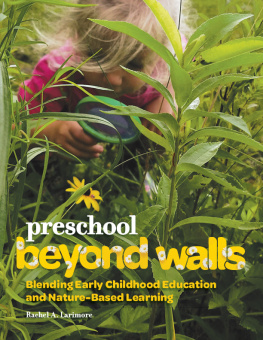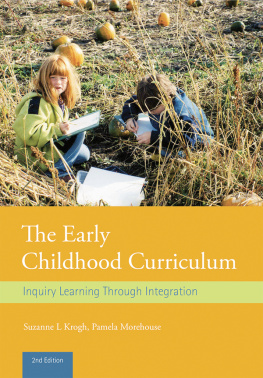

Published by Redleaf Press
10 Yorkton Court
St. Paul, MN 55117
www.redleafpress.org
2006, 2014 by Gaye Gronlund
All rights reserved. Unless otherwise noted on a specific page, no portion of this publication may be reproduced or transmitted in any form or by any means, electronic or mechanical, including photocopying, recording, or capturing on any information storage and retrieval system, without permission in writing from the publisher, except by a reviewer, who may quote brief passages in a critical article or review to be printed in a magazine or newspaper, or electronically transmitted on radio, television, or the Internet.
First edition published 2006. Second edition 2014.
Cover design by Jim Handrigan
Cover photograph omgimages/iStock/ThinkStock
Interior design by Percolator
Typeset in Chaparral
Photograph on by Danielle Vigh.
Photographs on (right) by Gail Holtz.
Photographs on by Jarrod Green.
Excerpts on . Reprinted with permission.
Excerpts on are from Early Childhood Education at a Crossroads, Harvard Education Letter 21 (4): 13, by Deborah Stipek. Copyright 2005. Reprinted with permission.
Excerpts on . Reprinted with permission.
Excerpts on are from Got Standards? Dont Give Up on Engaged Learning! Young Children 63 (4): 1420, by Judy Harris Helm. Copyright 2008 NAEYC. Reprinted with permission.
Excerpts on are from Investing in Our Future: The Evidence Base on Preschool Education, a report by Hirokazu Yoshikawa, Christina Weiland, Jeanne Brooks-Gunn, Margaret R. Burchinal, Linda M. Espinosa, William T. Gormley, Jens Ludwig, Katherine A. Magnuson, Deborah Phillips, and Martha J. Zaslow. Copyright 2013 Foundation for Child Development. Reprinted with permission.
Excerpt on . Reprinted with permission.
Library of Congress Cataloging-in-Publication Data
Gronlund, Gaye, 1952-
Make early learning standards come alive : connecting your practice and curriculum to state guidelines / Gaye Gronlund. Second edition.
pages cm
Summary: Updated to reflect current state standards across the country, this new edition provides practical help, support, and clear explanations on how to make early learning standards relevant and useful in your classroom or program Provided by publisher.
Includes bibliographical references.
ISBN 978-1-60554-369-7 (e-book)
1. Education, PreschoolStandardsUnited States. 2. Education, PreschoolCurriculaUnited States. 3. Curriculum planningUnited States. I. Title.
LB1140.23.G76 2014
372.210973dc23
2014007496
Dedication
To Judith Paiz, Dan Haggard, and colleagues at the Office of Child Development and Public Education Department in New Mexico: thank you for giving me the opportunity to learn so much through our work together.
To Brian Michalski, Rhonda Clark, and Cindy Zumwalt at the Illinois State Board of Education: thank you for allowing me to assist in your field test and revision of your early learning standards.
And to all of the early educators throughout the country who work so hard to meet standards and document childrens progress while remaining true to whats best for young children.
Contents
Thanks to:
Beth Wallace for leading the charge on the first edition of this book and initiating the ideas and format involved
Eileen Nelson for editing the first edition
Jarrod Green for joining me in writing of this edition to help teachers make learning evident to others through effective documentation strategies
David Heath and Kyra Ostendorf for their support in editing and producing the second edition
S tandards, standards everywhere! For several years now, standards have been the buzz in the field of early childhood education. There are standards that determine the number of children recommended for each teacher in a room. There are standards for the types of learning preschool children should experience. And there are child outcome standards, which are standards that define what young children should be learning. This book will focus on the latter: What are the reasonable expectations that guide early educators in planning curriculum for preschool children and in assessing their progress in achieving those expectations?
The call for accountability in education, including early childhood education, is evident in the media, in the federal and state governments, and from the parents and family members that early educators work with on a daily basis. Preschool education has gotten much more attention in the last few years with many states offering prekindergarten (pre-K) programs and federal efforts being introduced to offer pre-K nationwide. With this increased attention, pressures can result from misunderstanding of learning in the early years with questions such as: When is it best for young children to know all of their alphabet letters or to learn to count? Preschool teachers may feel defensive in explaining the importance of playful learning and unsure of how best to justify what they have considered best practices for young children. Early learning standards can be a way to address accountability and provide more information about appropriate expectations in the early years.
Early learning standards for young children are all around us. As of 2013, all fifty states have identified standards for preschool children ages three to five. In addition, a majority of states have developed or are in the process of developing standards or guidelines for infants and toddlers ages birth to thirty-six months. In its report titled The Research Base for a Birth through Age Eight State Policy Framework, the Alliance for Early Success cites the importance of early learning standards as a part of policies that support the healthy development of young children. Here is how the Alliance defines and explains standards:
Learning standards or guidelines articulate what children should know and do at all stages of development. In early childhood, these standards and guidelines typically address cognitive skills (language, reading, math, science) and foundational skills (social skills, behavioral control, motivation, problem solving) because both are essential for success in school and in life. (Tout et al. 2013, 36)
With such emphasis in the field of early childhood education, how can you, as an educator, use standards in ways that are beneficial to the children? How can you

 implement standards in a way that is developmentally appropriate and good for the children?
implement standards in a way that is developmentally appropriate and good for the children?

 figure out reasonable and efficient ways to assess the childrens progress toward the standards?
figure out reasonable and efficient ways to assess the childrens progress toward the standards?


Next page





